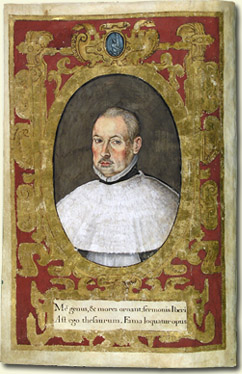|
THIS DVD CONTAINS
the entire lexicographical
corpus of Sebastián de Covarrubias. The editors, Ignacio
Arellano and Rafael Zafra, have integrated into the Tesoro de la
lengua castellana o española (1611) the manuscript pages
of the Suplemento that the author left scrupulously prepared and ready for press
upon his death. The editors have reconfigured the structure of the entries
as well, within reason and respecting the original ideas of
Covarrubias, a task complicated both
because of the orthographic variations of Covarrubias himself,
as well as the unfortunate interventions of the printer. The
additions made by Benito Remigio Noydens in his 1674 edition
have likewise been maintained, though placed separately in an appendix. The text has been
illustrated with an abundant array of engravings and emblems
from the period that richly document the work.
In this DVD – offered here independent of the book published by
the Iberoamericana/Vervuert - the reader will also find, in
addition to the complete edition by Ignacio Arellano and Rafael
Zafra, the photographic facsimiles of the
Tesoro and of the Suplemento, with each of their pages
linked to the transcription of the entries that it contains. As
is the case for all of the editions of Studiolum, this DVD
features a refined search menu
that allows for precise consultations
throughout the entire corpus: by language, groups of words,
refrains or proverbial phrases, etc. A special
characteristic of our digital editions is that each individual user can create
a personal
annotation of the text – that is to say, in essence a
personalized edition – by means of the simple creation of a
personal work file called a “shadow file”.
Studiolum has collaborated in the revision of the Latin and
Hebrew texts in this edition by Arellano and Zafra. But we are
already preparing a SECOND EDITION,
which will include, transcribed literally and indipendently, the
text of the 1611 edition and the Suplemento, in order to
allow searches by using the original spelling, and which will
allow the user to see immediately the original order of the
entries. For these texts we provide a copious system of
philological annotation with the
complete citation of the classical sources.
And the Hebrew scholar George Sajo clarifies for us the
utilization - often very obscure - that Covarrubias makes of
more than 800 Hebrew etymologies.
This second edition of the DVD will include
other important Spanish lexicographical
texts prior to Covarrubias. And, finally, we believe that
it is very important to point out that this edition will feature
active links to the
Diccionario de Autoridades, the CD of which is almost
finished, and whose publication date we hope to announce in the
very near
future.
Edition: 2006 — ISBN: 963-87196-0-5
|
| |

Titles included:
• Covarrubias
Horozco, Sebastián de,
Tesoro de la lengua
castellana o española,
Madrid 1611
• Covarrubias
Horozco, Sebastián de,
Suplemento al Tesoro de la lengua castellana
o española (manuscrito, Madrid, Biblioteca Nacional)
• Noydens,
Benito Remigio, Adiciones al Tesoro de la lengua castellana o
española, Madrid 1674
• Arellano,
Ignacio, “La edición integral e ilustrada del Tesoro de
Covarrubias”
• Reyre,
Dominique, “Las llaves del Tesoro de Covarrubias”
|
”
El DVD permite una rica
variedad de búsquedas, saltos
hipertextuales y otros modos de dominar el texto. En los tiempos
que corren, pocas veces se ha aprovechado mejor el esfuerzo de
unos estudiosos y los buenos dineros que la empresa habrá
costado.
Francisco Rico in his
review
in El País, June 17, 2006
|
Titles included in the second edition in preparation:
• Alfonso de
Palencia, Universal vocabulario en latín y en romance (Seville,
1490)
• Elio Antonio de Nebrija, Vocabulario español-latino (Salamanca, 1495?)
• Pedro de Alcalá, Vocabulista arábigo (Granada, 1505). Published
together with a short Arte para ligeramente saber la lengua arábiga
• Alejo Venegas, «Declaración de algunos vocablos»,
in
Agonía del tránsito de la muerte (Alcalá, 1565)
• Juan Lorenzo Palmireno, Vocabulario del humanista. Barcelona, 1575
• Francisco López de Tamariz, Compendio de algunos vocablos arábigos introduzidos en la lengua castellana. Aparece at
the end of the Diccionario de romance en latín by
Nebrija, Granada, 1585
• Bernardo de Aldrete,
etymological glossaries of Arabic origin based on fray Pedro de Alcalá,
in his Del origen y principio de la lengua castellana, Rome, 1606, lib. III.
And on about 200 «vocablos antiguos…» in lib. II, cap. VI.
• Gonzalo Argote de Molina
includes at the end of his edition of the El Conde Lucanor (Seville, 1575)
an «Índice de algunos vocablos antiguos que se hallan en este libro, para noticia de la lengua castellana»
• Diego García del Palacio, Vocabulario de los nombres que usa la gente de la mar. Appended
to the Instrucción náutica para el buen uso y regimiento de las naos (México: Pedro Ocharte, 1587, ff. 119-156v)
• Andrés de Poza, De la antigua lengua, poblaciones y comarcas de las Españas (Bilbao, 1587)
• Alonso Sánchez de la Ballesta,
Diccionario de vocablos castellanos aplicados a la propiedad latina (Salamanca, 1587)
• Diego de Guadix, Recopilación de algunos nombres arábigos… (de) ciudades. Manuscript
ready for print in 1593
• Cristóbal de Chaves, Vocabulario de Germanía.
Published in Barcelona, 1609 (Chaves died in 1602) as a work by
Juan Hidalgo
• Juan Alonso de los Ruyzes de Fontecha,
Diccionario médico. Aparece in his Diez privilegios para mujeres preñadas (Alcalá de Henares, 1606)
• Francisco del Rosal, Origen y etimología de la lengua castellana,
manuscript of 1601, with later additions
• Bartolomé Valverde, Tratado de etimologías de voces castellanas, manuscript
of 1600
• Tomé Cano, Declaración de vocablos que se usan en la fábrica de baxeles, Seville, 1611 |